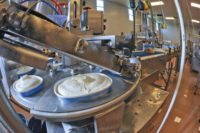
Public Displays
by Lynn Petrak
The role of public refrigerated warehouses in
cold-chain management grows with inventories and distribution channels.
The dairy industry always
has been unique in the food chain because of the perishability of its
products. When dairy foods and beverages were stored for distribution, it
usually wasn’t for very long.
For many processors, the same holds true today. But as
manufacturers offer more products with a longer shelf life and branch into
dairy-based ingredients, they are pursuing a broad range of warehouse
options, including off-site locations managed by third-party operators and
sites fitted with increasingly sophisticated technologies. Just like other
aspects of dairy production, storage is being driven by the need for more
efficient, cost-effective and customized solutions.
The Pros of PRWs
One way dairies are thinking outside their own box, so
to speak, is to look beyond private facilities to a public refrigerated
warehouse (PRW). A variety of cold-storage companies specialize in PRW
networks for the storage and handling of frozen and chilled dairy
products.
It is a business that continues to expand, quite
literally. According to recent industry research, there are currently 3.1
billion cubic feet of cold storage capacity in the United States, nearly
twice the space that was available two decades ago.
Public cold-storage sites are an appealing option for
a number of reasons. “PRWs play a vital role for food processors of
all types. They offer flexibility, lower costs and elimination of warehouse
management issues,” says Jerome Scherer, vice president of national
sales, marketing and government affairs for Cherry Hill, N.J.-based United
States Cold Storage (USCS), which provide storage, order selection and
distribution services for frozen and chill products, including ice cream
and novelties, butter, cheese, yogurt and powdered milk, among other items.
The ongoing expansion of dairy product lines is
another factor in the growing interest in using PRWs in addition to or in
place of private cold-storage areas. Bill Daniel, corporate communications
for full-service, multi-temperature storage company Henningsen Cold Storage
Co., Hillsboro, Ore., cites more diverse inventories and more sophisticated
distribution channels. “Food and dairy processors need to focus on
production, quality control and getting their products to market in a
timely manner. PRWs play a big part in that, as we can act as their main
storage partner as well as having forward distribution centers,” he
says, adding that the company works with dairies that manufacture frozen
and chilled items, including ice cream, milk, butter and cottage cheese.
Meanwhile, just as the dairy industry has expanded and
consolidated in recent years, so too have customers in the distribution,
retail and foodservice industries. In turn, their demands have had an
impact on the cold supply chain. “Most grocery outlets won’t
buy whole truckloads of dairy products because of their short shelf
life,” Daniel says. “Having a PRW in the mix to store full
truckloads, then shipping smaller quantities to the grocery distribution
centers, helps the processor move large quantities of product to multiple
locations taking advantage of full truckload savings and not having to
worry as much about short shelf life on their products.”
Just as appealing as the convenience and flexibility
of a PRW is the relative cost, say some providers. “Processors do not
always want to make the major investment required to build a large scale
refrigerated warehouse,” Scherer says.
A PRW is not a solution for every processor, of
course, and the choice is often made based on the inventory itself.
“It depends on the product. Products like milk, butter and sour cream
all have to hit the shelves as quickly as we can get them there. But for
longer shelf-life items, a lot of companies would opt to send it to a
PRW,” reports Chris Palumbo, vice president of the food group at The
Facility Group, an Atlanta-based multi-service design and construction
management firm. Although Palumbo says most of the company’s work is
dedicated to fixed or private cold storage facilities, there are a number
of processors looking for PRW storage of ESL products, bulk aged cheeses
and dairy ingredients like whey powder.
Control Issues
As they would with any on-site facility, dairies that
use PRWs for either short-term storage of fresh dairy products or
longer-term inventory of ingredients, bulk cheeses and shelf-stable items
rely on cold-storage suppliers to provide the proper environment.
Temperature control is obviously critical in cold
storage environments. “Manufacturers are good at manufacturing and we
are good at cold air,” Daniel says. “We have HACCP programs and
we conduct mock recalls with some of our dairy customers to ensure absolute
safety of the food chain and only the highest quality products reach the
consumer.”
Scherer also underscores the ability of PRW suppliers
to provide state-of-the-art temperature features. “PRWs are run by
professionals who are completely focused on the issues of proper handling,
storage and rotation of products no matter the temperature
requirement,” he says, adding that the dairy industry is distinct in
some ways compared to other food and beverage processors. “The
biggest challenge in serving the dairy industry is the super-low
temperatures required — minus 20 degrees Fahrenheit for ice cream
storage — and the need to properly track date codes of fast-moving
chilled items to assure proper rotation.”
Even shelf-stable products like dairy ingredients
require proper temperatures to ensure freshness and quality, especially if
those products are to be exported. “Products like whey powders
require temperature and humidity control,” Palumbo says.
In addition to temperature control, PRW operators have
pursued other types of technologies to help customers better manage their
inventories of frozen and chilled products. Automated storage and retrieval
systems are one example, and are being used in both public and private
cold-storage sites to monitor and track inventories and save on labor and
time expenditures. “Automation is something people are looking at
more,” Palumbo says.
The ability to trace and track products through the
supply chain is keeping up with the pace of technology, too. “We are
very specialized with the very latest in technology for warehouse
management systems, transportation management systems and real time
information services via the web,” Scherer says, noting that the use
of identification and tracking systems have improved dramatically in recent
years. “We have implemented radio frequency barcode systems for
inventory control at all 30 of our facilities nationwide. We are also
working with major customers to help them develop their RFID (radio
frequency identification) strategies.”
Linked with traceability is food safety, a concern
taken just as seriously by third-party providers responsible for the
products under their roofs. In addition to temperature control and HACCP
systems, many cold storage sites are subject to audits, from both third
parties and from customers.
Because safety encompasses security issues these days,
PRWs also have taken steps to bolster security measures at their sites. One
example is Canadian cold storage company Versacold, with a U.S. site in
Lake Geneva, Wis., which recently reported security changes like installing
video surveillance cameras with Web-based monitoring capabilities and
adding secure swipe-card access systems. The company, which warehouses ice
cream among other frozen products, has worked to improve and comply with
cross-border security measures as well.
Beyond constructing bigger and better warehouses,
cold-storage companies are offering a broader range of services to PRW
users. The Facility Group, for example, supplies facility planning, program
management, architecture, engineering, construction management, operations
consulting and financing services. In addition to warehouse management and
operations, USCS offers transportation management, import/export services
and value-added services such as quick freezing, storage of bulk
commodities and retail and foodservice products, order selection, and
distribution through its freight consolidation program.
Meanwhile, beyond its 37 million cubic feet of frozen
and refrigerated warehousing space, Henningsen is a resource for services
such as specialized product handling, cross docking, transloading,
import/export services, shipment consolidation, load pooling and physical
distribution.
To be sure, as cold-storage companies tout their high
tech, diversified capabilities and as dairies begin to move products away
from their own property for storage, the dynamics of the cold chain
management are shifting. Although many dairies have concentrated on
modernizing their private warehouses, PRW providers report brisk business.
“Our company is growing rapidly every year with annual new
construction expenditures between $50 million and $75 million,”
Scherer says.
Daniel says managing the growth has become a focus for
cold-storage operators like Henningsen. “Growth is a challenge in
today’s climate,” he observes. “The PRW business is very
competitive today and there are many challenges still ahead, whether you
operate one warehouse or 1,000 warehouses.”
Finally, those who supply technology and services to
PRW operators and private warehouse operators agree that cold storage is at
a crossroads of sorts. “The real challenge for the cold storage
facility people is, do they become part of that cold chain management or
don’t they?” says Ron Cropsey, marketing manager for Realcold
Milmech, USA Ltd., a Kansas City, Mo.-based supplier of automated carton
freezers for private and public warehouses. “Historically, both like
a bit of independence. But both bodies are moving closer together, with the
big cold-storage companies moving closer to the client and the client
allowing it to happen.”
Lynn Petrak is a freelance journalist based in the
Chicago area.
$OMN_arttitle="Public Displays";?>
